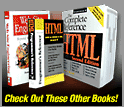

 |
 |
|||

|
Introduction
A thick Web design book without glossy paper and pictures! Who would have thought it would be published? That's exactly what I set out to do a few years back and it seemed to make sense to enough readers that now it has even been massively updated. Why engage in such a fool's errand? Simply because there are plenty of Web design books out there that provide color snapshots of well-implemented sites or short discussions of the cool features in today's trendy sites. However, given the fluid nature of the Web, the interesting sites have often changed by the time the ink has dried on the pages, leaving only a paper record of what the site used to be like. Worse yet, what is left only tells part of the story. It often hides the usability problems, the technical execution problems, and the slow loading pages. Even so, I often turn to such resources as they provide a great deal of visual inspiration. But they tell only half the story—and I will try to tell the other half in this book.The goal here is to talk about what makes sites work beyond the trends of the latest font or visual treatment. Usability will certainly be a major concern, but so will correct construction. I'll try to speak from the experience I gained from building hundreds of sites over the years with my firm. Some of the projects worked well and others didn't, and I found that I learned not only from my successes, but also from the failures of both my own projects and those I have observed or rescued. Experience is truly the best teacher in an industry as young as Web design. I'll try to make sure to teach the fine balance between designer wants and user needs, between form and function, and between uniqueness and consistency, all while respecting what is possible to execute in the chaotic medium known as the Web. After reading this book, you'll truly appreciate how Web design is a fluid mixture of art and science, inspiration and execution, and ultimately, of frustration and elation. You may excel on the visual side of a site only to fail in the technology or delivery aspects. Web design is all-encompassing and the investment in understanding deeper medium and technical issues will pay huge dividends in future projects. Yet as you read this book, you might not always agree with what I have to say. You may even find that some of the rules and suggestions are not perfectly consistent. However, that may be the point—to get you to think and not dismiss something out of hand. Instead, ponder why such rules and suggestions were developed before you throw caution to the wind. Great designers, regardless of medium, bend or break established rules on purpose. Real breakthroughs rarely come due to ignorance or arrogance. Unfortunately, I won't be able to guarantee a proven step-by-step process that ensures a great Web site. Some things really do take practice. Building numerous sites and browsing even more sites is required to excel at Web design. However, I can say that if you do read this book, you'll have at least half of what you need to make great sites. The rest will be up to you and your creativity. So get out there and show the Web what you can do! Thomas A. Powell tpowell@pint.com August 2002 |
Overview | Chapters | Examples | Resources | Buy the Book! |